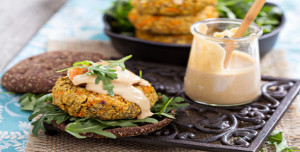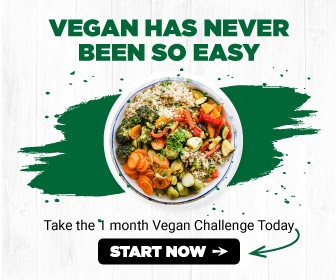 As vegans, we are often questioned about getting enough protein. But how much protein is enough? And what are some good vegan sources of protein?
As vegans, we are often questioned about getting enough protein. But how much protein is enough? And what are some good vegan sources of protein?
Protein serves as the body’s building blocks, and having sufficient protein is essential for the body’s growth and maintenance. Among other tasks, protein builds muscle, repairs cells, plays critical roles in processes such as metabolism and digestion, and transports vitamins and minerals throughout the body.
The importance of protein to the health of our bodies cannot be overstated. Too much protein, however, has been linked to health problems such as osteoporosis and kidney stress.
The U.S. government recommends that we get a minimum of 0.8 gram of protein per kilogram of our body weight day per day. This equals about 0.36 gram of protein per pound of body weight. Here are some specific examples of protein recommendations for people of different weights:
Body Weight = 125 pounds = 56.8 kilograms = 45 grams of protein per day
Body Weight = 150 pounds = 68.2 kilograms = 55 grams of protein per day
Body Weight = 200 pounds = 90.9 kilograms = 73 grams of protein per day
Body Weight = 225 pounds = 102.3 kilograms = 82 grams of protein per day
To make the math easier, you could round the amount of protein up to one gram per kilogram of body weight per day. Since 0.8 gram of protein per kilogram of body weight is the minimum recommendation (approximately 15% of our caloric intake), using one gram instead of 0.8 gram is a safe estimate for most people to use.
Pregnant or breastfeeding women and athletes have higher protein requirements. People suffering from kidney disease are usually advised to limit their protein intake in order to reduce stress on the kidneys. If you have specific health concerns, you should consult with a qualified nutritionist.
Now that we have a better idea of how much protein our bodies require, let’s take a look at some vegan sources of protein. Remember that many vegan sources of protein have fewer calories per serving than non-vegan sources of protein.
Beans
There are many varieties of beans from which to choose, and they all have similar amounts of protein – about 6 grams in a half-cup serving. Lentils, which are classified as legumes, contain 9 grams of protein in a half-cup serving.
Nuts
A powerhouse of protein, a one-ounce serving of nuts has a protein content ranging from 2.25 grams (macadamias) to 6.7 grams (peanuts). Most nuts provide between four and six grams of protein per one-ounce serving. Nuts also have a fairly high fat content; while these are considered to be “good” fats that can help reduce cholesterol, it is still important to be aware of how much fat is consumed. Nuts can be enjoyed whole and raw, roasted and salted, or in the form of nut butters.
Seeds
Pumpkin seeds have a whopping 8.5 grams of protein in a one-ounce serving! Flax seeds, which are also good sources of omega-3 fatty acids, contain 1.9 grams of protein in a one-tablespoon serving. Be sure to grind them up (they can be purchased pre-ground) so that the nutrients are absorbed by the body. A tablespoon of sesame seeds has 1.6 grams of protein, and one ounce of sunflower seeds provides 5.5 grams of protein.
Tofu
Tofu, which is made from soybeans, can be cut into cubes and used in stir-fry dishes, blended into dips and smoothies, and incorporated into a number of different recipes. A half-cup serving of tofu contains 11 grams of protein and only 100 calories! Some soy products – such as soy yogurt, tofu hot dogs, and other “fake meats” – are also good sources of protein.
Soymilk and Other Vegan Milks
Drinking soymilk is a good way to get protein and also calcium, since most vegan milks are fortified to have as much calcium as cow’s milk. One cup of soymilk has 7 grams of protein. There is a rather wide range of protein content in different varieties of almond milk, though the average almond milk has about 8 grams of protein in a one-cup serving. Rice milk has only a very modest amount of protein, and oat milk has a bit more protein than rice milk. Check the labels of vegan milks if you want to use them as a source of protein.
Tempeh
Tempeh (pronounced TEM-pay) is made by combining fermented soybeans with a grain, such as barley or rice. It is much firmer than tofu and has a slightly sour flavor due to the fermentation. It is best prepared for use in recipes by steaming it for 20 minutes. Tempeh can be used in stir-fry and other dishes, and it contains 17 grams of protein in a four-ounce serving. Please click here to see a number of tempeh recipes.
Seitan
Also referred to as wheat gluten or wheat meat, seitan (pronounced SAY-tan) is made from wheat protein. It is thick and chewy, making it an excellent meat substitute. A four-ounce serving of seitan has 26 grams of protein and 160 calories. Seitan can be purchased ready-to-use, or you can make your own seitan at home.
Quinoa
A recently “rediscovered” grain, quinoa (pronounced keen-WAH) offers 8 grams of protein in a 1-cup (cooked) serving.
Other Whole Grains
Many grains offer excellent protein content. Here is just a sampling of one-quarter cup dry (pre-cooked) servings and their protein content: amaranth (7 grams), barley and buckwheat (5.7 grams each), millet (5.5 grams), oats (6.5 grams), wild rice (6 grams), brown rice (3.7 grams). Two slices of whole wheat bread provide 5 grams of protein.
Vegetables
While not typically thought of as protein sources, vegetables do contain enough protein to make a meaningful contribution to our diet. One cup of cooked broccoli has 4 grams of protein; a medium potato has 4 grams, and one cup of cooked peas contains 9 grams of protein. Other vegetables with relatively good protein content include mushrooms, cauliflower, spinach, and corn. But even cucumbers and carrots have a bit of protein to offer!
In the past, vegans were instructed to carefully combine proteins sources to ensure every amino acid (the building blocks of protein) would be present in every meal. It is now considered to be sufficient to simply eat a variety of foods during the day and week in order to get all the protein (and amino acids) necessary for good health.
It is easy for the average person with average nutritional needs to get all the protein they need from vegan food sources, so enjoy your cruelty-free meals without the worry!
More Articles about Vegan Living
If you are interested in improving your health, helping the environment, and taking a stand against animal cruelty, please visit Vegan Journey for more articles about vegan living by this author.
Article Source: http://EzineArticles.com/?expert=Valerie_Toizer_Bloom

Speak Your Mind